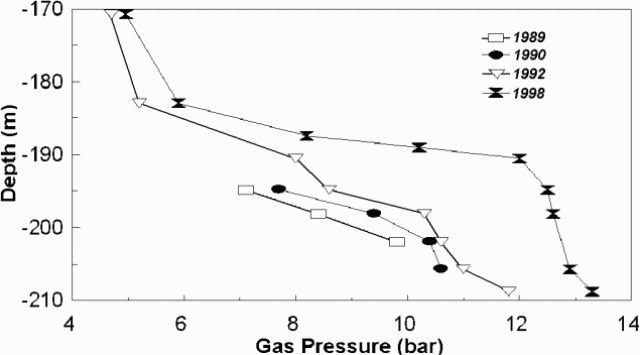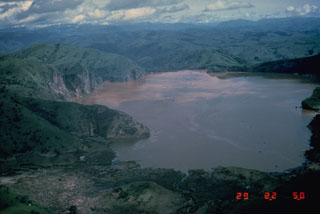Report on Oku Volcanic Field (Cameroon) — December 1998
Bulletin of the Global Volcanism Network, vol. 23, no. 12 (December 1998)
Managing Editor: Richard Wunderman.
Oku Volcanic Field (Cameroon) High CO2 at Lakes Nyos and Monoun, April-May 1998
Please cite this report as:
Global Volcanism Program, 1998. Report on Oku Volcanic Field (Cameroon) (Wunderman, R., ed.). Bulletin of the Global Volcanism Network, 23:12. Smithsonian Institution. https://doi.org/10.5479/si.GVP.BGVN199812-224030
Oku Volcanic Field
Cameroon
6.25°N, 10.5°E; summit elev. 3011 m
All times are local (unless otherwise noted)
Only three lakes in the world are known to contain high concentrations of dissolved gas in their bottom waters: Lakes Nyos and Monoun in Cameroon and Lake Kivu in East Africa. The release of large quantities of gas from lakes is very rare; however, massive carbon dioxide gas (CO2) releases from Lake Monoun in 1984 (SEAN 09:08) and Lake Nyos in 1986 (SEAN 11:08) resulted in the loss of nearly 1,800 lives.
A joint team comprising U.S., Cameroonian, and Japanese scientists continues to investigate the cause of these lethal CO2 releases, the potential for future events, and hazard remediation. The following is a summary of the team's preliminary findings as contained in a report for April-May 1998 (Kling and others, 1998).
The report stated that the total gas content in the two lakes was very high and continued to build from supplies of CO2 that discharge from underground springs in the bottom of the lakes. Likelihood of a gas release can be estimated from the degree of gas saturation (the ratio of gas pressure to hydrostatic pressure) in the bottom waters. Measurements established that the subsurface gas pressure is mainly due to dissolved CO2.
Figure 3 shows gas pressure plotted against depth in the lake from measurements made in Lake Nyos starting in 1989. Pressure has increased at all depths below 170 m since then; the largest increases occurred in the bottom 20 m of the lake. Gas pressure at lake bottom exceeds 13 bars, more than 60% of the saturation value based on an ambient hydrostatic pressure at that depth (21 bars).
 |
Figure 3. Gas pressure as a function of depth in Lake Nyos for four years (1989, 1990, 1992, and 1998). The 210 m depth represents the lake bottom. From Kling and others (1998). |
In Lake Monoun gas pressure also increased, reaching about 83% of the saturation pressure at 60-m depth. While the current gas saturation for both lakes remains below 100%, any large disturbance of the water column could trigger a violent release of the residual gas in these lakes. A frequently cited analogy to this process is the removal of the cap from a bottle of soda and the consequent drop in confining pressure enabling the gas dissolved in the soda to form bubbles. Once bubbles are formed in the lake they rise rapidly and drag the deep water toward the surface, drawing additional water upward in a chain reaction that can violently liberate enormous amounts of gas. Thus, the threat of a future lethal gas release is increasing.
A brief summary of the approximate water temperature and significant chemical parameters (alkalinity, pH, dissolved oxygen, and conductivity) in Lake Nyos as a function of depth is presented in table 1; the trends in Lake Monoun are similar. Comprehensive details are available in the complete report. Both lakes are warmer at shallow depths and near the bottom than at intermediate depths; for Nyos the coolest temperatures (~22.5°C) appear at near 40-m depth. Nyos lake water has become increasingly similar to that seen in 1985 prior to the massive CO2 release.
Table 1. Some physicochemical parameters of water in Lake Nyos. The temperature values are estimates taken from plots in the original report. Conductivity refers to specific conductivity in microSiemens per centimeter. Data from Kling and others (1998).
| Depth (m) | Temperature (°C) | Conductivity (µS/cm) | pH | Oxygen (mg/L as O2) | Bicarbonate (mg/L as HCO3-) |
| 0 | ~ 27.2 | 52 | 8.73 | 8.12 | -- |
| 30 | ~ 22.5 | 57 | 6.31 | 2.26 | 41 |
| 50 | ~ 22.5 | 526 | 5.46 | 0 | 371 |
| 100 | ~ 23.2 | 764 | 5.25 | 0 | 553 |
| 200 | ~ 25.3 | 1,500 | 4.95 | 0 | 1,102 |
A simple remedy to eliminate future lethal gas buildup involves removal of gas from the gas-rich bottom water of the lakes by pumping it through pipes to a suitable disposal area on the surface (BGVN 15:11). The scheme has been submitted by the Cameroonian government to the Japanese Embassy and Ministry of Foreign Affairs for funding. The energy released due to bubble formation (degassing) as the fluid rises is sufficient to drive the pumping operation without any external power source. This approach was validated by two demonstration projects, one in Lake Monoun in 1992 and one in Lake Nyos in 1995. In addition, future gas buildups can be prevented by continually flushing the bottom water out of the lakes through a pipe.
Lake Nyos has a weak natural dam at the outlet whose failure would cause a devastating flood that could affect up to 10,000 people in the downstream flood plain. However, pumping the gas-rich bottom water as noted above would also lower the lake water level, eliminating the flooding threat.
The people living close to these lakes need to be made aware of the risks from gas release and potential flooding. Toward this end, several Cameroonian Ministries have cooperated to produce a national plan for prevention and management of natural hazards.
In 1997 an international committee was established to help coordinate and advise the degassing efforts. This committee, named the NMDP Advisory Committee (Nyos-Monoun Degassing Project), includes members from six countries.
References. Kling, G., Evans, W., Tanyileke, G., and Kusakabe, M., 1998, Scientific investigation of Lakes Nyos and Monoun, Cameroon: Preliminary report, April-May 1998, for NMDP Advisory Committee. http://www.biology.lsa.umich.edu/~gwk/research/nm98rept.html.
Geological Summary. Numerous maars and basaltic cinder cones lie on or near the deeply dissected rhyolitic and trachytic Mount Oku massif along the Cameroon volcanic line. The Mount Oku stratovolcano is cut by a large caldera. The Oku volcanic field is noted for two crater lakes, Lake Nyos to the N and Lake Monoun to the S, that have produced catastrophic carbon-dioxide gas release events. The 15 August 1984 gas release at Lake Monoun was attributed to overturn of stratified lake water, triggered by an earthquake and landslide. The Lake Nyos event on 21 August 1986 caused at least 1,700 fatalities. The emission of ~1 km3 of magmatic carbon dioxide has been attributed either to overturn of stratified lake waters as a result of a non-volcanic process, or to phreatic explosions or injection of hot gas into the lake.
Information Contacts: George Kling, University of Michigan, Ann Arbor MI 48109, USA; William Evans, U.S. Geological Survey, Menlo Park CA 94025, USA; Gregory Tanyileke, IRGM, BP 4110, MINREST, Yaounde, Cameroon; Minoru Kusakabe, Okayama University, Misasa, Tottori-ken 682-0192, Japan.

